Place: Bourges, France
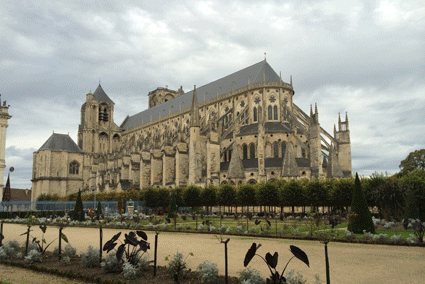
Bourges
photos Gail Priest
Bourges
Reason for travelling
From Oct 2014-Jan 2015 I was in residence in Bourges hosted by the media arts organisation Bandits-Mages in association with La Box, Ecole nationale supérieure d’arts de Bourges (ENSA) as part of the European Media Arts Residency Exchange program.*
Ancient alchemies and future fantasies
Bourges is situated in central France, two hours south of Paris by train. It’s an old, old town inhabited back in the BC by the Romans under the name Avaricum, surviving the invading Gauls due to its strong walls and surrounding marshland. It still boasts the remains of a fourth century Gallo-Roman wall or rampart hidden beneath modern wood and stonework. The end of the Middle Ages saw the town extend beyond the ancient walls with grand constructions such as the awe inspiring cathedral, Saint-Étienne de Bourges, begun in the 12th century, the Palais Jacques Coeur and the Hotel Lallement built in the 15th century and the former 16th century Jesuit seminary which is now the art school. There are of course the requisite sprawling modern suburbs (Bourges has a population of around 70,000), but the centre of Bourges is utterly magical, with cobbled streets, winding lanes and vertiginously tilting Tudor-style houses replete with carved woodwork often still intact. Given its age it’s not surprising that the town that has a strong association with things alchemical and feels a little haunted.
However I was in residence to think about the future, working on a project exploring science fiction and sound art, so in some ways I was living in parallel worlds, in a zone of cognitive dissonance. This disjunction was happily reinforced by the fact that this ancient city has a thriving contemporary culture particularly in the areas of media and video art, sound and experimental music.
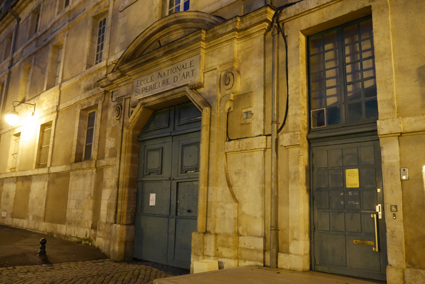
Ecole nationale supérieure d’arts de Bourges (ENSA)
photo Gail Priest
Ecole nationale supérieure d’arts de Bourges (ENSA)
Culture: connectivities, collectives and cooperation
While it’s not always the case that smaller towns breed closer connections, the intimate size of Bourges and its mix of proactive and passionate artists and arts workers results in good relationships between organisations which gives it an immediately tangible sense of community—one with an experimental, queer and underground bent.
My host organisation, Bandits-Mages was founded in 1991 by graduates from the local art school, Ecole nationale supérieure d’arts de Bourges (ENSA). It offers an annual program of workshops and projects particularly focussed on video, multimedia and digital art and also runs a festival, which since 2013 has become annual. The 2014 manifestation, Rencontres Bandits-Mages took place in November and I was a guest. Highlights from the eight day program included an impressive exhibition developed with Galerie Kapelica from Ljubljana, Slovenia comprising the ‘remains’ of performance art pieces that had been performed at the gallery by leading body artists such as Franco B and Kira O’Reilly. Also presented by Kapelica was Maja Smrekar who created a performance piece, K-9_topology: I Hunt Nature, and Culture Hunts Me (see video), with three wolf hybrids (in association of the Jacana Wildlife Studios which we also got to visit—I did not think I would be looking at lions and tigers in central France). Spanish duo Quimera Rosa offered an electro-kinky performance and workshop using Arduino circuits and body piercing to make the body a playable instrument; the exhibition Hall Noir presented risqué and high-camp video and performance installations in the impressive architecture of the old water tower, the Chateau D’eau; and there was a workshop conducted by writer/producer Pacôme Thiellement and actress Hermine Karagheuz with local students from ENSA making radiophonic pieces themed around alchemy which were broadcast on a temporary radio station.
As evident in the above, the association between Bandits-Mages and the art school remains strong and is mutually beneficial. ENSA is one of the seven nationally run art schools and is housed in an amazing 16th century building offering an enviable amount of hands on studio space. I was attached as a mentor to the Post-diploma in sound (something after a Masters and before a PhD). The students attend one week a month for lectures and to work on projects for a concluding exhibition. My residency was also attached to the La Box program which offers a number of three month residencies to artists (national and international) often with exhibitions in the school’s professional gallery.
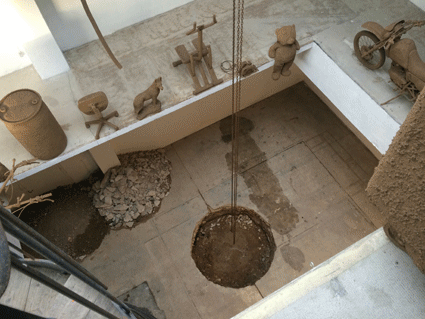
Laurent Faulon, Mon Ciel, Transpalette – Emmetrop
photos Gail Priest
Laurent Faulon, Mon Ciel, Transpalette – Emmetrop
Bandits-Mages is but one of the organisations in the arts complex La Friche L’Antre-Peaux which is just outside of the old town in a former industrial complex. Along with rehearsal studios, a circus and theatre company there is also Emmetrop which presents theatre, dance, music and exhibitions with a strong underground and queer agenda. The whole complex is fetchingly feral but is about to be renovated. This meant that Laurent Faulon, the artist presenting the last exhibition in the Transpalette space—a three story tower-like building—was given free rein. For his exhibition, Mon Ciel, Faulon excavated the central area of floor using the clay to coat a large number of everyday objects—ranging from oversized teddy bears to gumboots, to cement mixers to washing machines and even a motorcycle. These objects sat on the edge of the mezzanine levels of the tower that opened vertiginously into the void in the middle. Viewers ascend via a spiral staircase which always shifts the perspective of the whole. On the opening night the derelict roof allowed a misty shower to grace the inside of the building, pooling in the open cavity of the floor—a breathtaking integration of art and site.
Elsewhere around town are two venues for experimental music offering a truly underground experience; both are cellars, or ‘caves,’ in established old share houses. On my second night in town I was taken to the aptly named Odeur de Cave (ODC), the waft of centuries of mould and clouds of cigarette smoke offering the true scent of Europe. I was scheduled to play there at some stage but even in Bourges there are pesky neighbours: ODC had to cease activities for a while. However, the other venue, Cave 40, in collegiate Bourges style, put on the remaining shows. These artist-run venues present local, national and international artists doing all manner of things, mainly with electronic tools, to a dedicated and engaged audience there for the listening, the drinking, then later, sometimes, the dancing. These venues confirmed to me that whether it’s a warehouse in Marrickville in sweltering 40 degree heat or a cellar in France at a freezing four degrees, there’s a strong and vital community for noise and sonic experiment—and it always feels like home.
The overground cultural scene in Bourges, centred around the Maison de la Culture de Bourges (MCB), is currently homeless. The centre was in the process of being renovated when ancient archeological ruins were discovered and the site subsequently quarantined. At the moment the activities happen around the town with most of the dance and performance presented at the auditorium attached to the local Conservatory of Music. MCB produces a few of its own shows as well as forming part of an active regional touring circuit. I was very happy to catch the lovely life-affirming dance work of Christian Rizzo, D’après Une Histoire Vraie (see RT122).
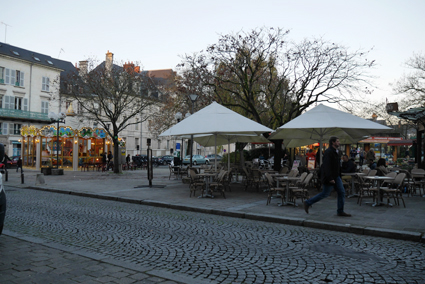
Le Cujas, Bourges
photo Gail Priest
Le Cujas, Bourges
For refreshment…
Bourges drinking and dining is in keeping with its ancient surroundings—traditional. A favourite place of those I often dined with is Le Guillotin on Rue Bourbonnoux near the Place Gordaine which offers an impressive array of grilled meats and their lamb and duck are pretty delectable. While I couldn’t bring myself to try to the horse steak tartare it was a favourite with one of my dining companions. At the other end of the Rue Bourbonnoux is La Gargouille which has a similar menu but with a slightly more modern interpretation and offers very nice desserts. I also spent a lot of time at Le Cujas in the centre of the old town because it was well appointed for someone hanging out alone—ie has small tables in corners with windows—and the waiters learned to put up with stumbling, incorrectly gendered French. Their Irish Coffees, with more than a healthy shot of whiskey and topped with cream, are just the thing on a cold afternoon.
The local wine regions of the area are Sancerre and Menetou-Salon and I prefer the white of the first and the red of the second. They seemed much lighter than my experience of French wines imported to Australia. Chinon is also nearby (closer to Tours) and wine from here offers a bit more oomph and that old mould taste (technical terms) while still being on the lighter side. But don’t be surprised when your half-carafe (a very civilised idea) comes with some bubbles from its extrication from a cask as this Australian invention has been well and truly embraced in France.
One of the most pleasant food related activities is going to the markets (open on Thurs/Sat/Sun at various locations), each big enough to feel rich and plentiful yet small enough to not be completely overwhelming. My favourite products are the wonderful local honeys made by bees that have supped on lavender and acacia; crottins de chevre (small goats cheeses of varying maturity and smelliness); big pears which, after you peel off their not so attractive tough brown skins, are like ambrosia; and the most perfectly packaged fruits, the clementine. Originating from Algeria it’s a neat little citrus related to but oh so much better than a mandarin.
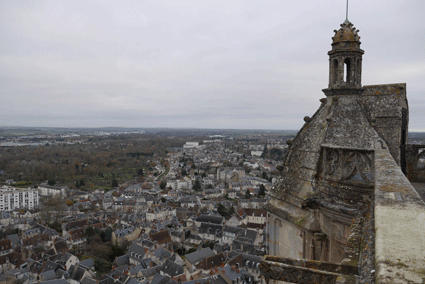
Bourges
photos Gail Priest
Bourges
And for the wanderer…
If feeling touristic, the climb up to the top of the bell tower of Saint-Étienne cathedral is worth the wheezy 396 steps offering a full 360-degree vista of the town and surrounding region. However be warned that the crypt tour takes 45 minutes (in French, and could be done in 10), making it feel like medieval torture. The Palais Jacques Coeur is particularly impressive. This local 15th century merchant and friend of King Charles VII was at one point the richest man in France. When charged with counterfeiting and fraud he tried to claim his wealth came from alchemy. His house is seriously weird and wonderful—a maze-like affair with ceilings like boat keels, an amazingly ornate personal chapel and what is possibly the first sauna in France.
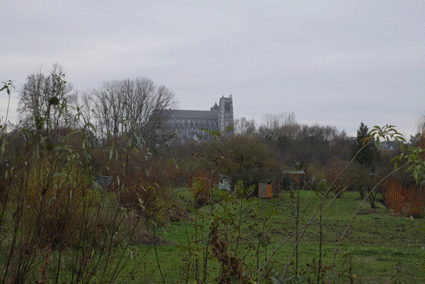
The Marais, Bourges
photos Gail Priest
The Marais, Bourges
Finally you can’t go to Bourges and not take a walk through the Marais—the marshland only 10 minutes walk to the northeast of the old town. Between snaking creeks and canals are nestled over 1,000 gardens, allotments and summer houses. Even in the dead of winter, the Marais is beautiful, in a spooky, melancholic way. And you can never really get lost because you can always see the towering Saint-Étienne cathedral to guide you back to the light.
*The residency was part of the European Media Arts Network: European Media Arts Residency Exchange (EMAN#EMARE) program which in 2014-2015 offers residencies to Australian and Canadian artists, with European artists hosted by Experimenta (see RT124), UTS Creativity and Cognition Studio and QUT’s The Cube. The project is supported by the Culture 2013 Programme of the European Commission and the Goethe Institut.
Thanks to the lovely people who hosted me and showed me around: Sandra Émonet, Isabelle Carlier, David Legrand, Julien Pauthier, Marta Jonville & Thomas, Ewen Chadronnet, Caroline Delaporte & Chris, Éric Grimault, Jean-Michel Ponty, Roger Cochini, Alexandre Castante, Chloé Nicholas, Véronique Frémiot, Manon Chavigny.
——————————–
Gail Priest is a sound artist, writer and curator. She has worked for RealTime since 1998 in various roles, currently as the Online Producer & Associate Editor. In 2015-2016 she is the Australia Council for the Arts Emerging and Experimental Arts Fellow.
Links
Bandits-Mages http://bandits-mages.com/
Galerie Kapelica http://www.kapelica.org
Maja Smrekar http://majasmrekar.org
Quimera Rosa http://quimerarosa.net
Ecole nationale supérieure d’arts de Bourges (ENSA) http://www.ensa-bourges.fr/
ENSA Post-diplome http://www.ensa-bourges.fr/index.php/fr/la-recherche/post-diplome-pratiques-sonores/presentation
La Box Residencies, ENSA http://www.ensa-bourges.fr/index.php/fr/galerie-la-box/residences
Emmetrop http://www.emmetrop.fr
Cave40 https://www.facebook.com/cave40; http://www.cave40.org/
the Maison de la Culture de Bourges (MCB) http://www.mcbourges.com/
Le Guillotin http://www.bourges-tourisme.com/entreprise/restaurant-le-guillotin-bourges/
La Gargouille http://www.bourges-tourisme.com/entreprise/la-gargouille-bourges/
Brasserie Le Cujas http://www.bourges-tourisme.com/entreprise/brasserie-le-cujas-bourges/
Saint Étienne Cathedral http://www.bourges-tourisme.com/en/pages/cathedrale-saint-etienne-de-bourges/
Palais Jacques Coeur http://www.bourges-tourisme.com/en/pages/palais-jacques-coeur-bourges/
Marais http://www.bourges-tourisme.com/en/pages/les-marais/
Related Articles
Triangulating the horizon
Gail Priest: MAAP, Land Sea Sky
RealTime issue #123 Oct-Nov 2014 p52
The melancholy poetry of machines
Gail Priest: Ian Burns, UTS Gallery
RealTime issue #121 June-July 2014 p49
In Profile: Lawrence English, Wilderness of Mirrors
RT Profiler 5, 30 July, 2014
The signals have been waiting for us
Gail Priest: Douglas Kahn’s Earth Sound Earth Signal
RealTime issue #120 April-May 2014 p47
Contributor profile: Gail Priest
RT Profiler 6, 17 September, 2014






